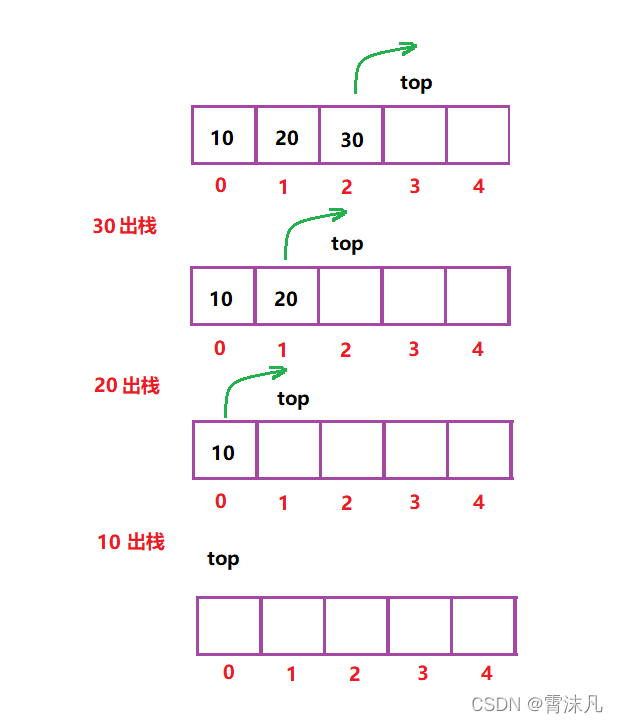数据结构(初阶)—— 栈和队列①
目录
一、栈的概念和结构
二、关于栈的选择题试练
试题一
试题二
三、静态栈与动态栈的选用
四、栈的各个接口函数的实现
1.栈的初始化
2.在栈顶插入数据 (入栈)
3.栈顶数据的删除(出栈)
4.取栈顶的数据
5.栈的元素个数
6.判断栈是否为空
7.栈的销毁
五、源代码
Stack.h
Stack.c
test.c
一、栈的概念和结构
栈:一种特殊的线性表,其只允许在固定的一端进行插入和删除元素操作。进行数据插入和删除操作的一端 称为栈顶,另一端称为栈底。栈中的数据元素遵守 后进先出 LIFO(Last In First Out)的原则。
二、关于栈的选择题试练
试题一
1.一个栈的初始状态为空。现将元素1、2、3、4、5、A、B、C、D、E依次入栈,然后再依次出栈,则元素出栈的顺序是( )。A、 1 2 3 4 5 A B C D E B、E D C B A 5 4 3 2 1C、 A B C D E 1 2 3 4 5 D、5 4 3 2 1 E D C B A
解析: 对于栈而言,栈的元素遵守先进后出,后进先出的原则;题目进栈的顺序是1、2、3、4、5、A、B、C、D、E,那么逆序就是它出栈的顺序,即:E、D、C、B、A、1、2、3、4、5;所以本题选 B;
试题二
2.若进栈序列为 1, 2, 3, 4 ,进栈过程中可以出栈,则下列不可能的一个出栈序列是( )。A 1, 4, 3, 2 B 2, 3, 4, 1C 3, 1, 4, 2 D 3, 4, 2, 1
解析:
所以本题选 C
三、静态栈与动态栈的选用
我们可以采用静态栈结构或者动态栈结构;静态栈需要我们开辟好足够的空间,这不是我们能控制的,如果用栈存储数据量小,开辟的空间又很大,这时候就存在浪费了;如果开辟的空间很小,又不够存放数据;我们通常使用的是动态增长的栈,只要空间不够就会增容;本次我们主要实现动态栈;
静态栈:
typedef int STDataType; #define N 1000 typedef struct Stack { STDataType a[N]; int top; //栈顶 }Stack;动态栈:
typedef int STDataType; typedef struct Stack { STDataType* a; int top; //栈顶 int capacity; }ST;
四、栈的各个接口函数的实现
1.栈的初始化
//栈的初始化
void StackInit(ST* ps)
{
assert(ps);
ps->a = NULL;
ps->top = 0;
ps->capacity = 0;
}2.在栈顶插入数据 (入栈)
//在栈顶插入数据
void StackPush(ST* ps, STDataType x)
{
assert(ps);
//插入数据时如果空间不够,就增容
if (ps->top == ps->capacity)
{
//我们创建的栈刚开始没有空间,可以采用三目操作符,先给它4个空间的大小;
int newcapacity = ps->capacity == 0 ? 4 : ps->capacity * 2;
STDataType* tmp = (STDataType*)realloc(ps->a, newcapacity * sizeof(STDataType));
if (tmp == NULL)
{
printf("realloc fail\n");
exit(-1);
}
ps->a = tmp;
ps->capacity = newcapacity;
}
ps->a[ps->top] = x;//把数据压栈(放到栈顶)
ps->top++;//记录数据的个数,同时也能知道栈顶得的数据值是多少
}3.栈顶数据的删除(出栈)
//栈顶数据的删除
void StackPop(ST* ps)
{
assert(ps);
assert(!StackEmpty(ps));//判断栈是否为空,为空则不能删除;
ps->top--;
}4.取栈顶的数据
//取栈顶的数据
STDataType StackTop(ST* ps)
{
assert(ps);
assert(!StackEmpty(ps));
return ps->a[ps->top - 1];//这里top是数据的个数,减去1就是对应栈顶的数据的下标
}5.栈的元素个数
//栈的元素个数
int StackSize(ST* ps)
{
assert(ps);
return ps->top;
}6.判断栈是否为空
//判断栈是否为空
bool StackEmpty(ST* ps)
{
assert(ps);
//不需要遍历数组,直接给有个判断表达式,如果top为0就说明栈为空
return ps->top == 0;
}7.栈的销毁
//栈的销毁
void StackDestroy(ST* ps)
{
assert(ps);
free(ps->a);
ps->a = NULL;
ps->capacity = ps->top = 0;
}五、源代码
Stack.h
#include
#include
#include
#include
typedef int STDataType;
typedef struct Stack
{
STDataType* a;
int top;//栈顶
int capacity;
}ST;
//栈的初始化
void StackInit(ST* ps);
//栈的销毁
void StackDestroy(ST* ps);
//在栈顶插入数据
void StackPush(ST* ps, STDataType x);
//栈顶数据的删除
void StackPop(ST* ps);
//取栈顶的数据
STDataType StackTop(ST* ps);
//栈的元素个数
int StackSize(ST* ps);
//判断栈是否为空
bool StackEmpty(ST* ps); Stack.c
#include "stack.h"
//栈的初始化
void StackInit(ST* ps)
{
assert(ps);
ps->a = NULL;
ps->top = 0;
ps->capacity = 0;
}
//栈的销毁
void StackDestroy(ST* ps)
{
assert(ps);
free(ps->a);
ps->a = NULL;
ps->capacity = ps->top = 0;
}
//在栈顶插入数据
void StackPush(ST* ps, STDataType x)
{
assert(ps);
//插入数据时如果空间不够,就增容
if (ps->top == ps->capacity)
{
//我们创建的栈刚开始没有空间,可以采用三目操作符,先给它4个空间的大小;
int newcapacity = ps->capacity == 0 ? 4 : ps->capacity * 2;
STDataType* tmp = (STDataType*)realloc(ps->a, newcapacity * sizeof(STDataType));
if (tmp == NULL)
{
printf("realloc fail\n");
exit(-1);
}
ps->a = tmp;
ps->capacity = newcapacity;
}
ps->a[ps->top] = x;//把数据压栈(放到栈顶)
ps->top++;//记录数据的个数,同时也能知道栈顶得的数据值是多少
}
//栈顶数据的删除
void StackPop(ST* ps)
{
assert(ps);
assert(!StackEmpty(ps));//判断栈是否为空,为空则不能删除;
ps->top--;
}
//取栈顶的数据
STDataType StackTop(ST* ps)
{
assert(ps);
assert(!StackEmpty(ps));
return ps->a[ps->top - 1];//这里top是数据的个数,减去1就是对应栈顶的数据的下标
}
//栈的元素个数
int StackSize(ST* ps)
{
assert(ps);
return ps->top;
}
//判断栈是否为空
bool StackEmpty(ST* ps)
{
assert(ps);
//不需要遍历数组,直接给有个判断表达式,如果top为0就说明栈为空
return ps->top == 0;
}test.c
#include "stack.h"
void StackTest1()
{
ST st;
StackInit(&st);
//1 2 3 4入栈
StackPush(&st, 1);
StackPush(&st, 2);
StackPush(&st, 3);
StackPush(&st, 4);
while (!StackEmpty(&st))
{
printf("%d ", StackTop(&st));//打印栈就是依次取栈顶的数据,打印出来4 3 2 1
StackPop(&st);
}
//用完后记得销毁栈
StackDestroy(&st);
}
int main()
{
StackTest1();
return 0;
}





